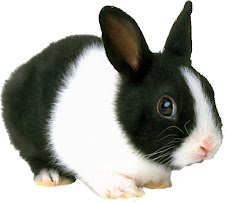The long ears of rabbits are most likely an adaptation for detecting predators. In addition to their prominent ears, which can measure more than 10 cm (4 in) long, rabbits have long, powerful hind legs and a short tail. Each foot has five digits (one reduced); rabbits move about on the tips of the digits in a fashion known as digitigrade locomotion. Full-bodied and egg-shaped, wild rabbits are rather uniform in body proportions and stance. The smallest is the pygmy rabbit (Brachylagus idahoensis), at only 20 cm in length and 0.4 kg (0.9 pound) in weight, while the largest grow to 50 cm and more than 2 kg. The fur is generally long and soft, and its color ranges through shades of brown, gray, and buff. Exceptions are the black Amami rabbit (Pentalagus furnessi) of Japan and two black-striped species from Southeast Asia. The tail is usually a small puff of fur, generally brownish but white on top in the cottontails (genus Sylvilagus) of North and South America
Rabbits are hindgut digesters. This means that most of their digestion takes place in their large intestine and cecum. In rabbits, the cecum is about 10 times bigger than the stomach, and it, along with the large intestine, makes up roughly 40% of the rabbit's digestive tract.[2] Cecotropes, sometimes called "night feces", come from the cecum and are high in minerals, vitamins and proteins that are necessary to the rabbit's health. Rabbits eat these to meet their nutritional requirements. This process allows rabbits to extract the necessary nutrients from their food
Rabbits are hindgut digesters. This means that most of their digestion takes place in their large intestine and cecum. In rabbits, the cecum is about 10 times bigger than the stomach, and it, along with the large intestine, makes up roughly 40% of the rabbit's digestive tract.[2] Cecotropes, sometimes called "night feces", come from the cecum and are high in minerals, vitamins and proteins that are necessary to the rabbit's health. Rabbits eat these to meet their nutritional requirements. This process allows rabbits to extract the necessary nutrients from their food







No comments:
Post a Comment